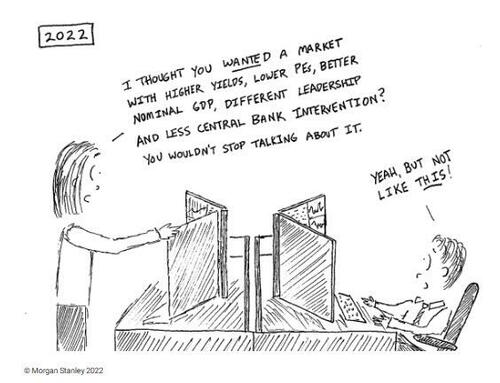Morgan Stanley’s 2023 Outlook: Growth Cools, Bonds Rule
By Andrew Sheets, Chief global strategist at Morgan Stanley
We’ll publish our year-ahead outlook later today. In the global economy, my colleague Seth Carpenter and our global economics team see a story of weaker growth, less inflation, and the end of rate hikes.
Let’s take those in turn.
Weaker growth is about continued deceleration of the global economy in 2022 into 2023. This slowing has several drivers, including some payback from excessive post-Covid consumer demand and bloated inventories in the retail sector. But the thrust of the slowing is driven by the (lagged) impact of policy tightening. The last 12 months have seen the fastest 12-month increase in the fed funds rate since 1981 and the fastest increase in ECB rates since the establishment of the eurozone.
Tightening usually works with a lag, and 2023 should be no different. The US barely avoids recession. The UK and eurozone do see recession, thanks to fiscal tightening (UK) and a large energy shock (eurozone). China growth recovers with our expectation that the Covid-zero policy is relaxed in the spring, but the rebound is muted, as deleveraging in the country’s real estate sector remains a challenge.
Slower growth should (finally) cool inflation. We understand the skepticism, given the persistent surprises this year, but we think that several forces are working to change the narrative:
-
Global demand should be weaker;
-
Supply chains are showing much less stress;
-
Inventories look increasingly elevated, inviting discounting for core goods;
-
Risk in shelter prices is much more balanced; and
-
Base effects shift materially (US gas prices are up 11%Y, but will be down 11%Y by March at current prices). US CPI is currently 7.7%Y, but we forecast it to be under 2.0%Y by the end of next year.
Cooling growth and inflation should lead central banks to pause and assess. They’ve just delivered significant tightening, tightening that works with a considerable lag. As growth and inflation cool, we think that the Fed pauses after a January rate hike at 4.625%, while the ECB pauses in March at 2.50%. EM central banks, which were well out in front of their DM counterparts, see some significant easing, especially in Hungary, Brazil, and Chile.
Any outlook is uncertain, but that’s especially true this year. We see risks to growth skewed to the downside, driven by more persistent inflation that drives a more forceful policy response. Significant uncertainty also exists around QT; we believe that central banks will show flexibility if it leads to systemic stress, but both central banks and investors are in uncharted waters with a balance sheet reduction of this scale.
For markets, this presents a very different backdrop. 2022 was marked by resilient growth, high inflation, and hawkish policy. 2023 sees weaker growth, disinflation, and rate hikes end/reverse, all with very different starting valuations. It seems reasonable to think that we’ll see different outcomes, especially in high grade bonds. We forecast US 10-year Treasury yields to end 2023 lower, the US dollar to decline, and the S&P 500 to tread water (with material swings along the way).
Indeed, we think that high grade bonds, one of the biggest losers of 2022, will be one of the biggest winners of 2023. Real and nominal yields have risen materially across a wide range of high grade markets. Less growth, inflation, and tightening make stable returns more attractive. We see attractive returns through end-2023 in Bunds, BTPs, EUR IG credit, US Treasuries, US IG credit, US municipals, agency MBS, and AAA securitized paper.
And we think that the ‘income’ theme extends further. Across many of our recommendations we have a bias toward the higher-yielding parts of the market, whether that’s US equities (where we’re overweight staples, healthcare, and utilities) or commodities (where we prefer oil to metals).
If ’embracing income’ is one key theme, ‘respecting sequencing’ is another. Markets face two great uncertainties for next year – will inflation/tightening moderate, and will growth bottom? We expect clarity on the first before the second. In turn, we generally prefer assets more sensitive to rate uncertainty than those more sensitive to DM growth.
This should support high grade bonds, which often do well after the last Fed hike regardless of whether a recession follows. But it should also support EM equities and debt. Early to underperform (EM equities peaked in February 2021), we think that they’ll be early to recover, similar to the early 2000s and 2008- 2022 has been a historically bad year for cross-asset returns. Next year won’t be easy, but it should look different.
Tyler Durden
Sun, 11/13/2022 – 16:00
via ZeroHedge News https://ift.tt/yFXZuJx Tyler Durden
